Marketers, sellers, and operators grow frustrated because of issues with Key Performance Indicators (“KPI”s). They should be: most marketing and sales strategy models are built on outdated financial frameworks. These stifle the impact of marketing and sales and hurt the entire business.
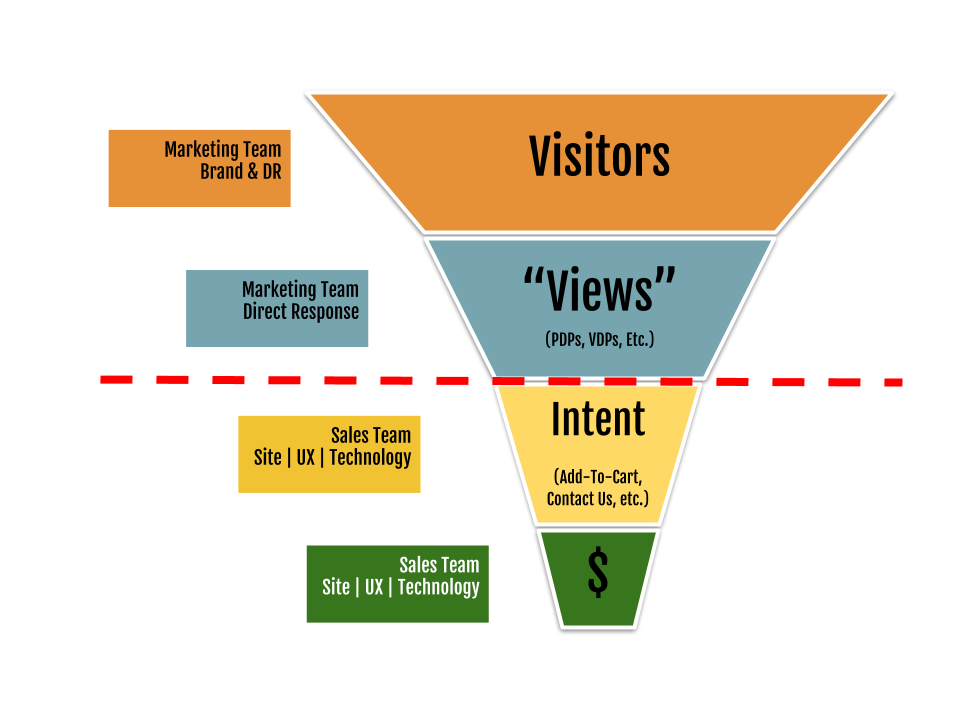
The marketing & sales funnel applied to the digital business. Many of your Excel pacing reports (on your screen, open right behind this tab) are built against basic strategic framework.
What is wrong with the marketing & sales funnel framework? It’s sometimes criticized because “customer journeys aren’t linear”. That is true – the days of generating mass awareness, narrowing down those who show interest, directly selling and then closing customers – in that order – are largely done thanks to the digital & information proliferation in every industry. But the biggest problem with the ‘funnel’ model isn’t it’s linear implications, it’s how the model assumes revenue derives from the product of individual, discrete and independent components. This is a massive problem. Let me explain:
The above funnel implies:
- Brand Marketing’s impact begins and ends with getting visitors to the website. Use media, generate exposure, and get more visitors into the sales funnel.
- Direct Response’s impact begins and ends with taking visitors, and generating response – or intent to purchase .
- Site, UX & Technology teams impact begins and ends with taking intent and converting it into transactions, both in rate (Conversion Rate) and volume (Average Order Value).
What could go wrong with this model? Quite a bit.

What’s gone wrong? The UX & Site teams are bickering at marketing for wasting money on junk traffic quality. The Marketing teams are tired of working around endless landing-page tests, or game their KPIs by directing traffic to product-description-pages without requisite customer intent. Merchants and brand marketers scramble for research into why fewer people are adding products-to-cart. Every team and customer grows tired of endless price promotion, or shameless cart cross-selling.
Let’s start at the top. “Visitors”. You can buy “visitors” of any kind & quality. If I sell shoes in Chicago, but I find cheap media exposure and “visitors” from Europe, will I move customers through the sales funnel? Of course not. And what about your existing customers – why do you think people pay so much for the next iPhone? Product reputation – sure – but brand affinity and loyalty are paramount as well. Where is that captured in this funnel?
Next comes the Direct Response team. If they need to generate cheap cost-per-product-pageviews to get rewarded (their “KPI” in this model), which would you do? Would you pay for highly qualified leads, who could convert into your biggest sales? Or would you find undersold / lower value traffic and direct them straight to a product pageview – even when that’s might be a worse user experience?
Finally, imagine being the Site or UX team given the two actions above. If your site used to convert 5% of traffic into sales, and you’ve just gotten the goal to increase that number by 20%, how will you do that with a new flood of cheap, poorly directed traffic to the site?
You can’t. The reality is that marketers aren’t just there to get more visitors, they are there to reach the right people. These funnel-based KPI models frustrates your teams, devalues their work and leaves them in the lurch when they do what you tell them to and it still doesn’t work.
But it’s not all the fault of business operations and the board room. Marketers and sellers often set themselves up to fail by championing these suspect KPIs. When this occurs, marketing “achieves targets” while the company stumbles. This eliminates credibility, reduces organizational trust, and hurts business outcomes.
How To Fix, Step 1: Eliminate Your Funnel
Anyone can calculate the funnel. The funnel looks great on a chart or a pivot table. Throw your marketing & sales funnel in the trash anyway. Funnel elements are outcomes, not goals. Dividing the metrics and KPIs so discretely allows for over-optimization. Teams optimize the sub-goal (say, PDP views) in lieu of the greater goal (sales $). Your measurement framework should reflect the contributions of each team towards the greater goal, and acknowledge that customer impact is at the heart of every successful strategy.
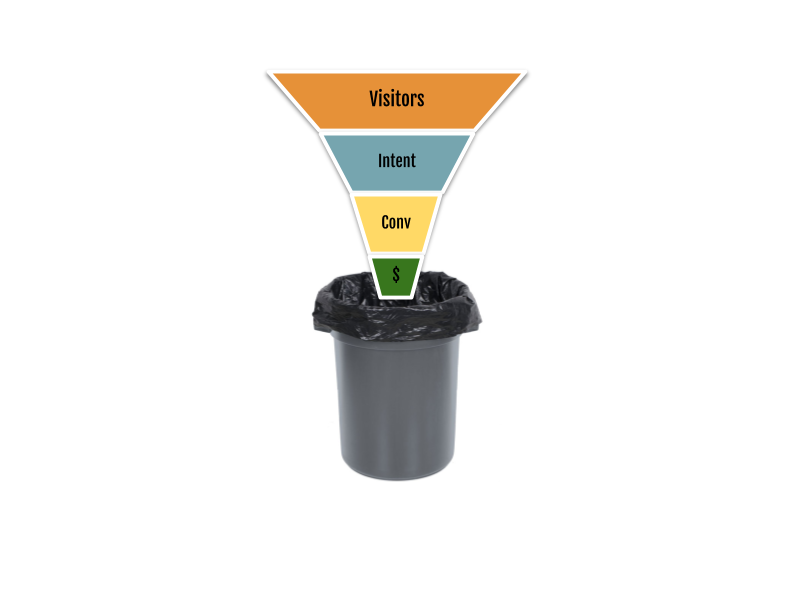
Pictured above: Marketing & Sales Funnel Optimization
Step 2: Deploy Customer Framework
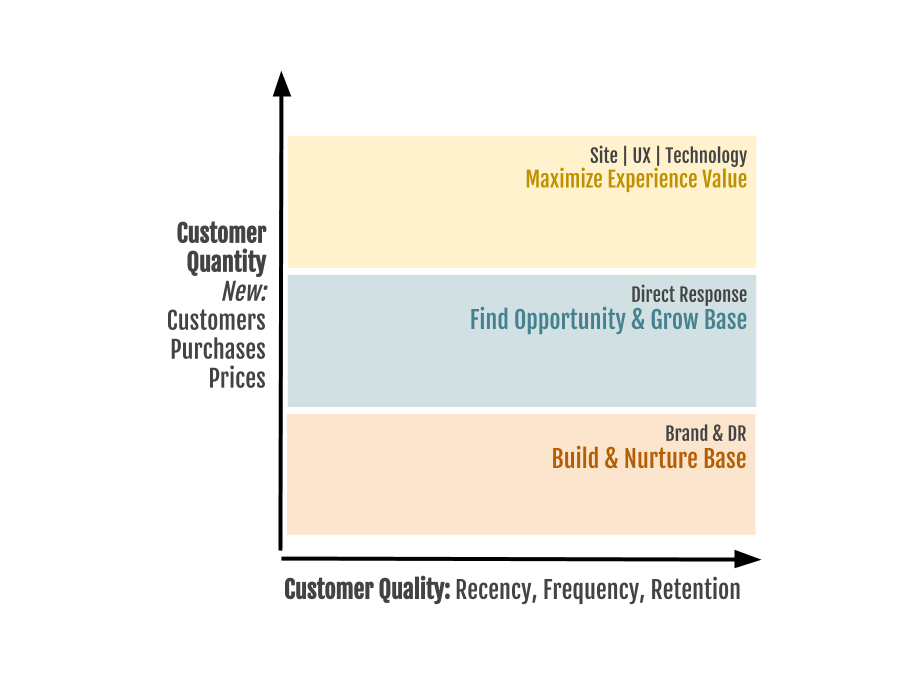
What’s better? Deploy a customer framework. This introduces two central changes:
1) It recognizes that profit & revenue comes from customers, and growth requires a combination of more customers, and more value from each customer.
2) You evaluate performance and outcomes not in discrete, linear ways (I.e. we need more traffic in the funnel, increase traffic no matter what), but in their dynamic impact to customer growth and value (i.e. we won more customers with a promotion, but did it lower our average customer value?)
Two other major improvements exist within a customer measurement framework. First, notice that Brand, Direct Response, and CX/Site all contribute to the same customer value chart. Second, each role contributes to both customer growth, and customer value.
Why is this so? It acknowledges that building a strong Brand requires awareness and new customer growth, but it equally requires nurturing your existing customers, increasing their loyalty and retention. Direct Response marketers are required to take high-intent prospects and convert them into customers, but they are also responsible for finding the right audiences to reach next. Finally, UX, Site, and other teams need to make the transaction experience seamless for customers, but they must lift current sales and future sales – they can’t simply pull future intent forward with endless price promotion.
Step 3: Emphasize Measurement Foundations
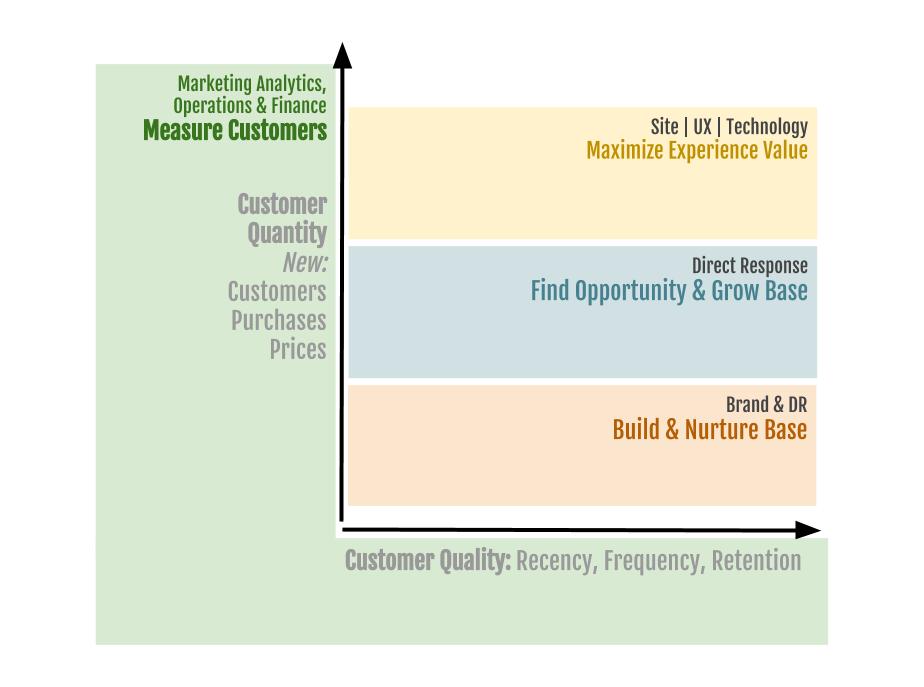
To move from linear sales funnel measurement to a customer framework, you need to be measuring outcomes through the customer lens! This means your analytics and measurement might need to evolve. If that’s the case, why isn’t this step one?
In practice, it should be. But you’ll need to win organizational buy-in before you worry about executing. Many organizations build sophisticated customer measurement before winning over hearts and minds in the boardroom. Win those first. This isn’t easy. You’ll need patience, empathy, and enthusiasm. The good news is this – your marketing analytics, operations and finance teams want this challenge. Give them the keys to your data governance kingdom, knock down walls and build consensus internally.
Step 4: Unify Customer Measurement Strategy
Once you are measuring your business through the lens of your customers, you can build out customer segments, plot them on your measurement framework, and assign clear KPIs centered on improving customer dynamics, not increasing a discrete metric in isolation. This model encourages collaboration, and ensuring positive progress towards short and long term performance growth.
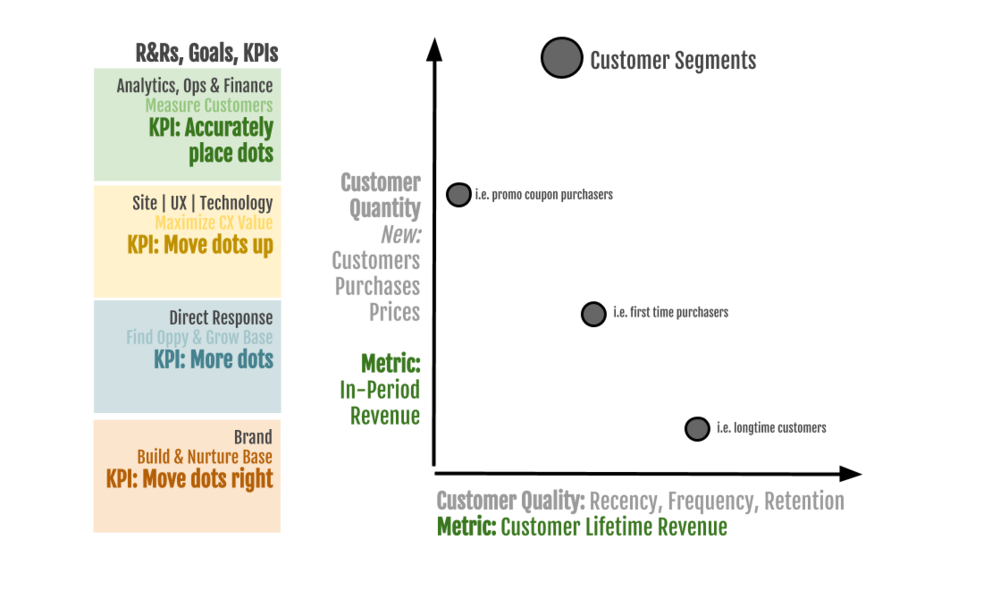
An example Customer Measurement Framework: One Chart, customer-centric, simple KPIs, clear roles, always serving both short and long term business objectives.
Step 5: Redeploy KPIs – Emphasize Company Targets
Once you’ve:
- measured customer outcomes
- plotted them on a customer framework
- assigned dynamic KPIs [hint: it’s about moving the dots up and to the right!]
your teams will be in a far better position to focus on making the right decisions for the business, while doing what they each do best. For instance, Marketing Analytics isn’t measured at all on a revenue number, but they are tasked with accurately measuring each customer segment on the chart! DR is responsible for more customer segments (dots), commercialization and UX teams are asked to help the purchase journey – loyalists and first-timers alike. Finally, Brand can focus on growing value across every segment: new, current, and loyal customers.
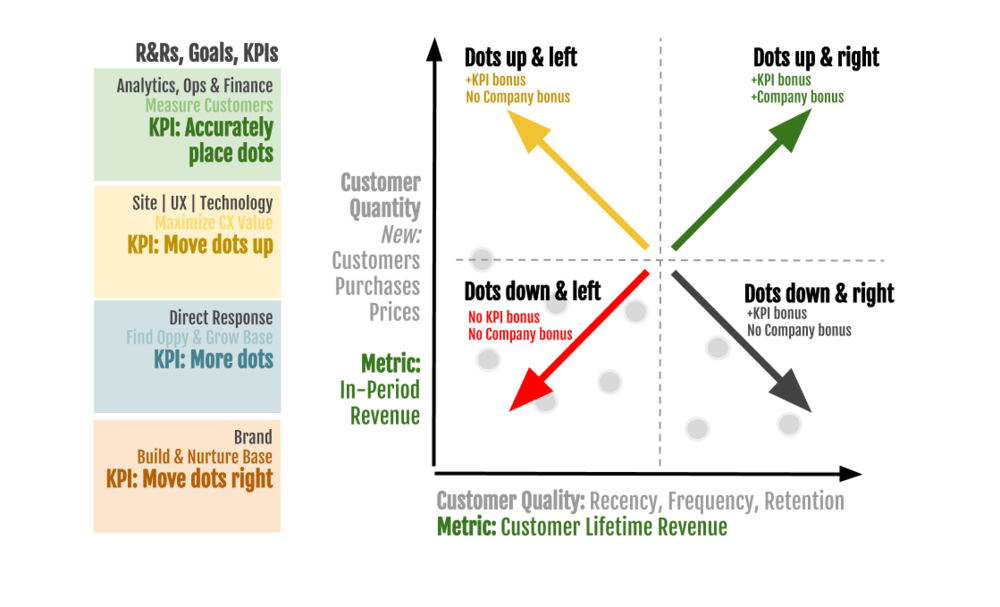
The example above might not perfectly fit your business, but no model is perfect. If you’d like to learn more about what this could look like for your business, let’s talk. At the very least, challenge your team to embrace what a Customer Measurement Framework could do for your business as you navigate this time of change.



